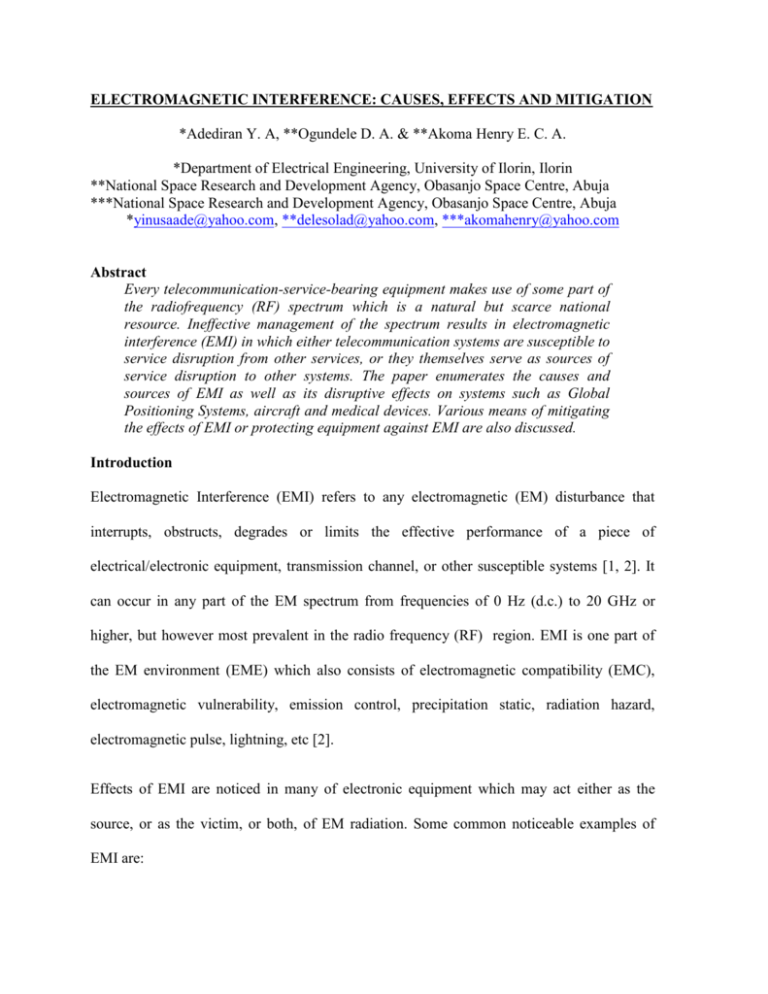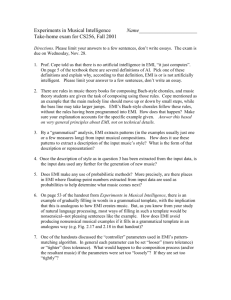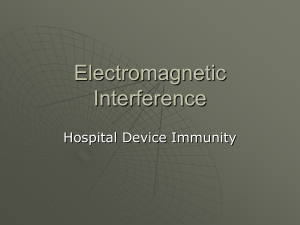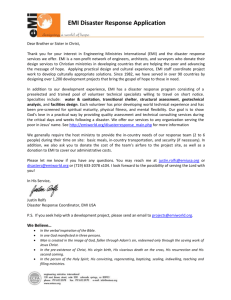electromagnetic interference: causes, effects
advertisement

ELECTROMAGNETIC INTERFERENCE: CAUSES, EFFECTS AND MITIGATION *Adediran Y. A, **Ogundele D. A. & **Akoma Henry E. C. A. *Department of Electrical Engineering, University of Ilorin, Ilorin **National Space Research and Development Agency, Obasanjo Space Centre, Abuja ***National Space Research and Development Agency, Obasanjo Space Centre, Abuja *yinusaade@yahoo.com, **delesolad@yahoo.com, ***akomahenry@yahoo.com Abstract Every telecommunication-service-bearing equipment makes use of some part of the radiofrequency (RF) spectrum which is a natural but scarce national resource. Ineffective management of the spectrum results in electromagnetic interference (EMI) in which either telecommunication systems are susceptible to service disruption from other services, or they themselves serve as sources of service disruption to other systems. The paper enumerates the causes and sources of EMI as well as its disruptive effects on systems such as Global Positioning Systems, aircraft and medical devices. Various means of mitigating the effects of EMI or protecting equipment against EMI are also discussed. Introduction Electromagnetic Interference (EMI) refers to any electromagnetic (EM) disturbance that interrupts, obstructs, degrades or limits the effective performance of a piece of electrical/electronic equipment, transmission channel, or other susceptible systems [1, 2]. It can occur in any part of the EM spectrum from frequencies of 0 Hz (d.c.) to 20 GHz or higher, but however most prevalent in the radio frequency (RF) region. EMI is one part of the EM environment (EME) which also consists of electromagnetic compatibility (EMC), electromagnetic vulnerability, emission control, precipitation static, radiation hazard, electromagnetic pulse, lightning, etc [2]. Effects of EMI are noticed in many of electronic equipment which may act either as the source, or as the victim, or both, of EM radiation. Some common noticeable examples of EMI are: - TV screen showing dots or roving pictures when a nearby computer system is being operated; - Noisy sound from a radio receiver operating near motorized equipment (e.g. grinding machines); - Lightning manifesting as noise in, particularly, AM radio receivers. The aforementioned effects could be considered as minor disruptive disturbances caused by EMI. Various other, and more serious/hazardous, effects of EMI had caused disruption in the operation of electronics on-board aircraft and have allegedly caused air disasters. Medical devices have also not been spared, particularly for people wearing pacemakers and other cardiac devices. The EMI Triangle Three entities are involved in the existence of electromagnetic interference, namely: Source, Victim, and Coupling Path. These are depicted in the EMI triangle of Figure 1 [2]. Source EMI Victim Coupling Path Fig. 1: The EMI triangle Source: This is the actual ‘emitter’ of electromagnetic energy, either intentionally (e.g. handheld radio transmitters) or intentionally (e.g. power transformer). Other sources include vehicle ignition, mobile electronics, lightning, power transmission lines, and atmospheric emissions. Victim: This is the device that is susceptible to EM energy emitted by the source. The level of EMI interference in the device depends on the immunity it has to reject the energy. Such victim can be a computer, TV system, radio receiver, medical devices, aircraft electronics, GPS, etc. Coupling Path: The means or mechanism through which EM energy is transmitted between the Source and the Victim is known as the Coupling Path. The physical distance between the Source and the Victim and their orientation play significant roles. Some common coupling mechanisms are - conduction through electric current; - radiation through EM field; - capacitive coupling through electric field; and - inductive coupling through magnetic field. The history of EMI could be traced back to World War II when it was referred to as radio frequency interference (RFI) and when majority of the high-tech electronic systems started to operate erratically. Conferences on EMI began to be held in the 1950s where classified information was presented. And as digital logic devices were being developed later in the 1970s, EMI became an issue, particularly in personal computers, communication equipment, intelligent transportation systems, sophisticated avionics, etc. [3]. Therefore, in the mid- to late 1970s, the Federal Communications Commission (FCC) of the United States of America began to promulgate an emission standard for some EMI emitting equipment. Today, many other national, regional and international regulatory bodies have developed emission standards in the relevant areas of jurisdiction. EMI and Air Transportation The use of some electronic/digital and electrical equipment has been prohibited in aircraft, particularly during take-offs and landings. Radio transmitters such as cellular phones and remote-controlled toys, are known to induce transient currents in electric wires (or cables) that can be amplified in the unshielded aluminium frame of an aircraft [4, 5]. The aluminium frame acts as a phased array antenna or a resonant cavity, thus compounding the effect of both internal and external EMI. This may result in change in the logic level of the bit stream, leading to rejection by error-correcting routines and eventual interruptions. High Intensity Radiated Emissions (HIRE) from radar, microwave relay stations, radio/TV transmitters and high power AM/FM radio broadcast systems can lead to disruptions in airplane navigation and communication systems and to possible loss of aircraft and human life. The electromagnetic pulse (EMP) is designed to permanently disable electronic devices within the reception area of the emitted signal which can originate from a nuclear or nonnuclear source. EMP is a directed energy source that can induce electric and magnetic fields with electronic systems to produce damaging current and voltage surges, and can produce catastrophic results with the power delivery systems, transportation systems (navigation and air traffic control), emergency services, and financial and banking services [6]. IEC categorized a peak electric field of 100 V/m or higher as high power. Therefore, some sources of high power electromagnetism (HPEM) include [7]: - lightning - radar fields - fields produced near electrostatic discharge, - EM pulse (EMP) produced by a nuclear detonation at any attitude, - Ultrawideband (UWB) fields. High altitude EM pulse (HEMP) came under investigation by United States Congress in 2001 [7] to investigate its potential impact with particular emphasis on the civil infrastructure. EMI and Medical Devices There have been reported cases of adverse effects of EMI on medical devices such as implanted cardiac devices (e.g. pacemakers and defibrillators), apnea monitors, powered wheel-chairs, blood pumps, hearing aids and electronic imaging devices [8, 9, 10]. Operation of these devices have been affected by EMI sources, particularly cellular phones. GSM phones that operate on (digital) TDMA can produce loud tones in some hearing aids up to 30 metres away and can reach 130 dB which is equivalent to the sound of an airplane at take-off [4]. The pocket and attached types of hearing aids are the most susceptible to EMI, though the easiest to control by shielding. Device manufacturers are also required to pay attention to shielding at the initial design stage, and work in consultation with the designers and manufacturers of EMI emitting devices. Restrictive use of wireless devices in hospitals and clinics could also be recommended, though difficult to enforce since both wireless communication devices and medical equipment must co-exist. Nonetheless, good consumer education on EMI and its effects should be provided, for example, through equipment’s operating/instruction manuals. Implanted cardiac devices such as pacemakers and implantable cardioverter-defibrillators have become victims of EMI which can produce ventricular standstill in the medical devices. [8, 9]. Digital cellular phones may, for example, interact with pacemaker function by inhibiting the pacing out system, particularly when the antenna is located near the pacemaker’s pulse operator header. Patients with pacemakers need to be regularly and carefully evaluated for any source(s) of EMI and other environmental factors that may interfere with their operation. Other major sources of EMI include fluorescent tubes, motors (or motorized equipment) and microwave ovens. The low frequency sources (fluorescent tubes, transformers, TVs and motors) work on electricity utility grid and are known to chronically stress the pineal gland which controls all the hormonal balances in a human body [10]. When the pineal gland is stressed, melatonin levels go down and sleeping problems may result. High frequency sources such as microwave ovens, broadcasting (radio and TV) systems and other proliferating wireless communication systems have also increased daily exposure to EMI, particularly in industrialized countries, all leading to more stress. EMI and Global Positioning System (GPS) The Global positioning System (GPS) is a space-based Global Navigation Satellite System (GNSS) which was initially developed for the military purposes (location and targeting). Its use has now extended to civilian applications such as maritime and aviation. Its applications therefore range from hand-held positioning and personal navigation devices to precision surveying tools. A typical GPS receiver on earth’s surface (with built-in microprocessors) must lock onto signals from at least four satellites, of twenty-four GPS satellites, to give full 3-D position (latitude, longitude and altitude), velocity (speed and direction) and time offset. The signals broadcast by the satellites in the GPS constellation travel nearly 300,000 km towards the earth’s surface through the atmosphere and are thus vulnerable to frequencyrelated effects while propagating through the tropospheric and ionospheric layers. In addition, broadcast signals by GPS satellites are extremely low power, hence vulnerable to EMI from sources such as broadcast TV, VHF transmitters, Portable Electronic Devices (PEDs), UWB radar and mobile satellite satellites service (MSS) communication systems. Intentional disruptions of GPS services are also possible through jamming and spoofing. A simple 1-4 Watt transmitter is known to be capable of disrupting GPS signals within an area of 100 nautical mile radius [6]. These disruptions affect the reliability, availability, integrity and accuracy of the GPS. The use of spread spectrum techniques (e.g. CDMA) in GPS allows multiple satellites to transmit on the same frequencies without interfering with each other, thus providing a high level of resistance to noise and interference. In addition, the GPS system uses a dualfrequency design that allows GPS receivers to compensate for the frequency-related effects of tropospheric and ionospheric layers. Residual Magnetism in Buildings Static magnetic field has been confirmed to be the cause of EMI with cathode ray tube (CRT) which forms an integral part of some medical equipment. Sources of such EMI are the electric welds of steel frames and deck plates in building structures housing the medical equipment [ 11, 12]. This is the reason for hospitals to - carry out residual magnetic field measurement; - place electronic equipment away from strongly magnetized points where strong magnetic fields are found; - de-magnetize affected equipment; and, - magnetically shield such EMI vulnerable equipment. Wen and Wang [13] have reported on the effective use of steel fibre cement (cement paste containing 0.72% 304 stainless steel fibres of diameter 8 μm and length 6 mm having a resistivity of 16 Ω-cm) as shielding material. A shield effectiveness of 70 dB at 1.5 GHz was attained. Earlier shielding materials produced made use of polymer-matrix composites containing electrically conductive filters. EMI COUNTERMEASURES From the foregoing discussion on the causes and effects of EMI, it is a requirement of every electrical/electronic circuit to be able to function in the real-world environment without failure or damage. Electrical equipment are not only required to be able to withstand interference from other sources, but at equally required to limit amount of interference they create. Such EMI problems are resolved by electromagnetic compatibility (EMC) whose requirements are regulated by many national, regional and international bodies like FCC, EU, CISPR, military standards, etc. Inter-system EMC requirement in MIL-STD-464 stipulates that a system is required to be electromagnetically compatible with its defined external electromagnetic environment such that its system operational performance requirements are met [14]. Some common EMC techniques are briefly discussed in the following paragraphs. EMI Shielding From Faraday’s cage principle, an effective way to minimize or eliminate EMI is to shield vulnerable victims from EMI. The shielding techniques, most of which have been recommended for medical equipment, are often expensive and may also cause major engineering design challenges, particularly when it is a requirement that the shield should completely enclose the equipment or circuitry. Elimination of the Source In theory, an effective way to eliminate interference is by identifying EMI sources and eliminating them. It is the most effective EMI countermeasure but not practical. Grounding A grounding point for an equipment serves to ensure the safety of the equipment and the operator. It also provides some immunity to noise and interference. Electric power transmission lines and equipment require proper grounding, but the conductor to be used should be as short as possible in order to avoid ground loop condition which could result in energy transfer by conduction to the ground [3, 6]. Filtering Filters are used to allow selected frequency signals to pass through to the connected device while rejecting others. Figure 2 shows a block diagram of a typical line filtering system in which a common mode filter is placed in the AC line in-between an impedance matching circuitry and a noisy power converter. AC line input Impedance matching Filter Figure 2: Generalised line filtering [15] Power converter Awareness There is the need for manufacturers and other stakeholders to inform users of EMI vulnerable devices and the sources of such disturbances. This should however be done after extensive investigations into EMI with such devices. This is particularly necessary for life-supporting medical devices such as apnea monitors which could fail to alarm due to EMI. Regulation A pre-market approach to ensure that any imported EMI vulnerable equipment is very essential. Device manufacturers/importers could, for example, be required to submit information about the safety and effectiveness of their devices, coupled with EMIcompliance tests thereafter. Similarly, regulation should also cover post-market areas whereby devices already in use are regularly subjected to EMI compliance-tests. CONCLUSION The paper has discussed the sources of electromagnetic interference and their effects on essential equipment such as aircraft, medical devices and global positioning systems. With adequate electromagnetic compatibility studies, such effects could be minimized or eliminated with the application of shielding, grounding and filtering techniques, amongst others. There may also be need for consumer awareness and strict compliance by manufacturers and marketers with anti-EMI regulations in every nation or region. REFERENCES 1. Field Management Services: Electromagnetic Interference (EMI) – Overview. www.fms-corp.com/interference_overview.php4. Accessed 8/5/2009. 2. US Marine Corps (1997): Electromagnetic Interference (Student Handbook). Annex A. HS-3.8. www.usmc.mil/news/publications/. Accessed 8/5/2010. 3. Montrose M. I. and Nakauch E. M. (2004): Testing for EMC Compliance: Approaces and Techniques. IEEE Press, NJ 4. Electromagnetic Interference. www.airnig.co.uk/ . Accessed 8/5/2009 5. Electromagnetic Interference in High Reliability Electrical Interconnect Systems. www.glenair.com/ . Accessed 8/5/2009. 6. Burrel J. (223): Disruptive Effects of Electromagnetic Interference on Communication and Electronic Systems. MSc Telecommunications Research project, George Mason University (April 2003), 34pp. 7. Radesky W. (2004): New developments in Intentional Electromagnetic Interference (IEMI) and High-Altitude Electromagnetic Pulse (HEMP). Metatech Corporation 8. Yara L. and Reddy P.C. (2007): Effects of Electromagnetic Interference on Implanted Cardiac Devices and their Management. Cardiol. Rev., Nov-Dec, 15(6), pp30043009. 9. Erdogan O. (2002): Electromagnetic Interference on Pacemakers. Indian Pacing Electrophysiol. J., July-Sept, 2(3), pp74-78. 10. Hall J. (1997): The Negative Effects of Electromagnetic Fields. Consumer Health, Canada, vol 20, Issue 1, Sept, pp1-5. 11. Kellogg J. (2008): Electromagnetic Interference (EMI) and Structural Vibration Effects on MRI Site Construction and Installation Requirements. ETS-LINDGREN. www.consumerhealth.org/ . Accessed 18/10/2010. 12. Hanad E, Takano K, Mishima H, Kodama K, Antoku Y, Watanabe Y, and Nose Y. Possibility of Electromagnetic Interference with Electronic Medical Equipment by Residual Magnetization in a Building with Steel Structures. www. ieee.org/organizations/newsletters/emcs/sprng01/PPmin.htm. Accessed 8/5/2009. 13. Wen S. and Cheng D.D.L (2004): Electromagnetic Interference Shielding reaching 70 dB in Steel Fiber Cement. Cement and Concrete Research, Pergamon Press. vol 34, pp329-332. 14. Department of Defense (1997): Department of Defense Interface Standard MIL-STD464: Electromagnetic Environmental Effects Requirements for Systems, 18/31997. 15. Coilcraft (2007): Common Mode Filter Design Guide. Document 191-1. www.coilcraft.com/ . Accessed 18/10/2010.







